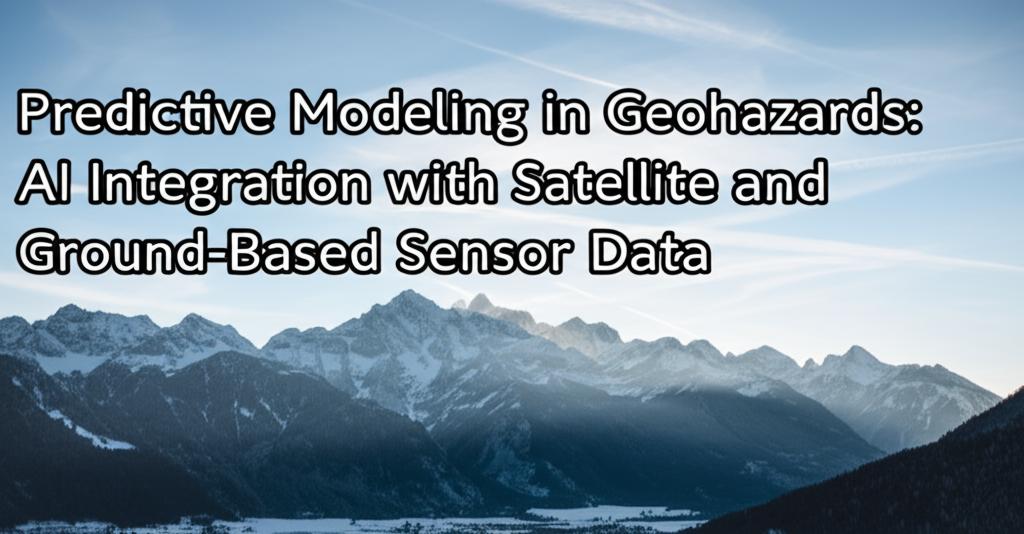Integrating Artificial Intelligence (AI) with data from satellites and ground-based sensors is revolutionizing our ability to predict and mitigate geohazards like landslides, earthquakes, volcanic eruptions, and subsidence. This fusion of technologies allows for more accurate, timely, and comprehensive hazard assessments.
Leveraging Diverse Data StreamsModern geohazard monitoring relies on a vast network of sensors. Satellites provide wide-area coverage, capturing data like ground deformation using Interferometric Synthetic Aperture Radar (InSAR), optical imagery for visual change detection, and thermal imaging for volcanic activity. Ground-based sensors, including GPS/GNSS stations, seismometers, tiltmeters, rain gauges, and IoT devices, offer high-resolution, continuous measurements at specific locations.
The challenge lies in effectively processing and interpreting these massive, heterogeneous datasets. This is where AI, particularly machine learning (ML) and deep learning (DL), proves invaluable.
AI's Role in Data Fusion and Pattern RecognitionAI algorithms excel at identifying complex, non-linear patterns within large datasets that might be missed by traditional analysis methods.
- Data Fusion: AI techniques can integrate diverse data types (e.g., spatial satellite imagery, temporal ground sensor readings, geological maps, weather data) to create a more holistic understanding of the factors contributing to a potential hazard. Algorithms learn the complex interdependencies between different parameters.
- Pattern Recognition: ML models can be trained on historical data of past geohazard events and corresponding sensor readings. They learn to recognize subtle precursors or combinations of factors that indicate an increased likelihood of an event. For instance, specific patterns of ground deformation measured by InSAR and GPS, combined with rainfall intensity from ground sensors, can be identified by AI as indicators of slope instability preceding a landslide.
- Predictive Modeling: Once trained, these AI models can analyze real-time data streams from satellites and ground sensors to forecast the probability, timing, location, and potential magnitude of future geohazards. Deep learning models, like Convolutional Neural Networks (CNNs) for image analysis and Recurrent Neural Networks (RNNs) for time-series data, are particularly effective.
- Early Warning Systems: By providing faster analysis and identifying precursors earlier, AI integration significantly enhances early warning systems, giving authorities and communities more time to prepare and respond, potentially saving lives and reducing economic losses.
Recent advancements focus on developing more robust and interpretable AI models. Techniques like physics-informed neural networks aim to incorporate known geological and physical principles into the AI models, improving their reliability even with limited historical data. Explainable AI (XAI) methods are also being explored to understand why an AI model makes a specific prediction, increasing trust and utility for decision-makers.
Applications are rapidly expanding:
- Landslide Susceptibility Mapping & Prediction: AI models analyze slope angle, soil type, land cover, rainfall (ground sensors), and ground deformation (InSAR, GPS) to predict landslide risk in near real-time.
- Earthquake Forecasting & Aftershock Prediction: AI analyzes seismic data (seismometers), crustal deformation (InSAR, GPS), and historical seismicity patterns to improve short-term earthquake probability assessments and predict aftershock distributions.
- Volcanic Unrest Monitoring: AI integrates seismic activity, ground deformation (tiltmeters, InSAR), gas emissions (ground/satellite sensors), and thermal anomalies (satellite imagery) to assess volcanic unrest levels and potential eruption timelines.
- Subsidence Monitoring: Combining InSAR data with groundwater level sensors allows AI to predict land subsidence rates, crucial for urban planning and infrastructure management.
Despite progress, challenges remain. Integrating vastly different data types (varying resolutions, formats, frequencies) is complex. Ensuring sufficient high-quality training data, especially for rare, large-magnitude events, is crucial. Model validation, interpretability, and managing computational costs are ongoing areas of research.
The future points towards more sophisticated sensor networks (including drone-based sensors), improved satellite constellations offering higher resolution and revisit times, and advanced AI algorithms capable of real-time, autonomous analysis and prediction, leading to more resilient communities in the face of geohazards.

